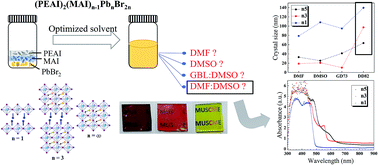Modifying morphology and defects of low-dimensional, semi-transparent perovskite thin films via solvent type†
Abstract
(PEA)2(MA)n−1PbnIn+1Br2n perovskites are semi-transparent, color-tunable thin films with broader band gaps. They have the potential for semi-transparent solar cell and smart window applications. Solvent engineering significantly alters the morphology, absorbance, crystallinity, charge separation, and defects, thereby influencing the optoelectronic properties. Herein, we investigated the effect of the solvent type on the low dimensional, mixed halide perovskite thin films (n = 1, 3, and 5) and identified DMF : DMSO = 8 : 2 as the most suitable solvent. The mixed solvent regulated the growth rate of perovskites, which led to the smooth morphology and larger crystallite size. Through surface photovoltage spectroscopy and time resolved photoluminescence, good charge separation and low defects were linked to DD82 usage.



 Please wait while we load your content...
Please wait while we load your content...